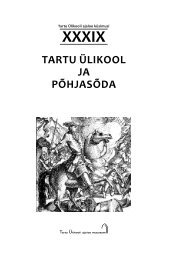TarTu ÜlIkool ja Põhjasõda - Tartu Ülikooli Ajaloo Muuseum
TarTu ÜlIkool ja Põhjasõda - Tartu Ülikooli Ajaloo Muuseum
TarTu ÜlIkool ja Põhjasõda - Tartu Ülikooli Ajaloo Muuseum
Create successful ePaper yourself
Turn your PDF publications into a flip-book with our unique Google optimized e-Paper software.
mariann rammo<br />
Destruction as an opportunity<br />
How the Great Northern War affected the <strong>Tartu</strong><br />
urban environment development and identity<br />
162<br />
MA MARIANN RAMMO<br />
Institute of History and Archaeology of the University of <strong>Tartu</strong><br />
The use of the term “social space” was probably most profoundly affected<br />
in the 20 th century by Henri Lefebre (1901–1991), according to<br />
whom this space is produced, reproduced and shaped by human activities<br />
Based on this aspect, the author reviews the formation of the<br />
<strong>Tartu</strong> urban environment from the 17 th century until the beginning<br />
of the 19 th century<br />
As a result of the Great Northern War (1700-1721), <strong>Tartu</strong> sustained<br />
enormous material and spiritual damage It is therefore entirely<br />
logical that historical publications in Estonia have so far treated the<br />
consequences of the Great Northern War for <strong>Tartu</strong> as an unequivocal<br />
disaster Yet destruction often causes something new to appear, the<br />
value of which can only be assessed with critical hindsight If the Great<br />
Northern War and several large fires in the 18 th century had not taken<br />
place, the urban environment and identity of <strong>Tartu</strong> would have probably<br />
evolved into something very different from what we have now<br />
After the Great Northern War <strong>Tartu</strong> rose from the Middle Ages<br />
into the Modern Age The new epoch for <strong>Tartu</strong> was primarily characterised<br />
by openness in every sense of the word: openness to new<br />
frontiers, new identity and new people<br />
Previously enclosed in the old town walls and jealously defending<br />
its rights above all others, <strong>Tartu</strong> now had open architectural planning<br />
and increasingly favoured open-mindedness Destruction of the<br />
medieval fortifications during the Great Northern War made <strong>Tartu</strong><br />
an open city much earlier than it would become fashionable elsewhere<br />
in Europe <strong>Tartu</strong>’s future was no longer to be a garrison town,<br />
either. The Great Northern War created the basis for the emergence<br />
of a qualitatively new identity: <strong>Tartu</strong> as an open and international<br />
university town



